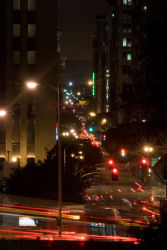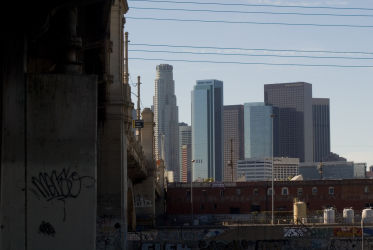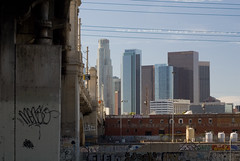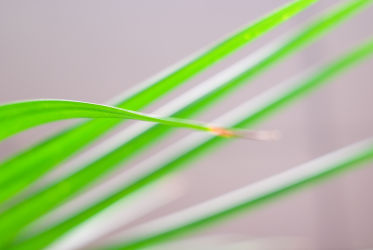Building a Phone System: Part 1
March 07, 2007 by Eric Richardson
Monday I started build-out on a new phone system for the office. I've never done this before, so I thought it might be cool to document the process here.
I got hired by Cartifact as a programmer, but it's not exactly my nature to stick just to that. I have a penchant for thinking I can do all sorts of things, so this fall I wrote up a proposal to replace our aging, cumbersome PBX with an Asterisk system and VoIP phones. The bosses gave the go-ahead, and now here I am building a phone system.
Sixth Street at Night
February 07, 2007 by Eric Richardson
The head for my tripod came in yesterday so I wasted no time in taking it out to play. Of course I then managed to run my camera battery too low for comfort, so I didn't last too long.
In the time I did have I was playing with taking shots down Sixth street, which runs east through Downtown. For distance reference, the green neon for the Hayward Hotel is about .7 miles from where I'm standing.
Hardware wise, I picked up Giottos MT-9170 tripod legs. The MT series features a center post that can do all sort of odd things, sticking off to the side, straight down, etc.
I then got a Kirk BH-3 ballhead and Kirk's A100-specific L-bracket. It's the first time I've used a ballhead, so I don't feel like I'm in much of a position to make a review right off. That said, from one night of playing I'm very happy.
A Polarizing Comparison
February 06, 2007 by Eric Richardson
I ordered a tripod recently, and at the same time picked up a polarizing filter. This weekend I shot with it for the first time while out taking pictures of the river and the Sixth Street bridge.
The two shots you see at right show what an effect the filter can have on skies. The top picture is without filter (or actually just with it turned and not active), and you can see how the foreground and building fronts are darkened because in order to maintain the sky.
With the filter the sky is brought down enough that the highlights on the bridge and the foreground buildings really come out. You'll also notice how some clouds in the sky are picked out, where in the first version they just blend into the blue.
You can see this all better in the larger versions.
An Accidental Background Image
January 20, 2007 by Eric Richardson
I was messing around with my camera before I left the office Friday and took this shot of a plant. I didn't have any purpose for it at the time, but after looking at it in the computer later I decided it would make a nice background image. A little Photoshop resizing and cropping later and there it was gracing the screen of my laptop.
I used to be all over desktop wallpaper. If you look back at old screenshots of mine you see all kinds of fanciful imagery. But somehow that changed. The desktop on my computer at work is still the Apple default, as was my laptop's until just today.
Accounting for Bad Links
January 20, 2007 by Eric Richardson
Over on blogdowntown (as well as here) I use a little bit of Javascript to allow longer posts to start out collapsed, but give the user the ability to expand the body in place as desired. It's old code, from well before I knew anything of AJAX.
When a post is expanded or collapsed, an anchor name is added to the end of the URL, using the post ID as a key. This lets the browser scroll to the appropriate spot so that the post that was clicked is the one visible. So if the user clicks to expand post '2475,' the end of the URL will now read '/#2475.'
Simple enough.
Occasionally, though, someone links to that URL instead of using the permanent link for the post (which, using this example, would be '/blog/2475'). That works fine while while the post is on the front page, but after a few more posts go up that content is no longer anywhere to be found.
Thursday LA Observed linked to a post using the # syntax. In light of that, I was a little cautious about when I let the linked post fall out of the first five. Today, though, I had something new ready to go and needed a solution.
What I did was add a little Javascript to the main page for blogdowntown that checks for # syntax in the browser location. If it sees a #id, but doesn't see that id in the page, it loads the post and sticks it after the five posts that would normally be there. It then tells the browser to scroll down to the newly loaded content.
And best of all, it was easy. Javascript after the jump... — Continue Reading...




